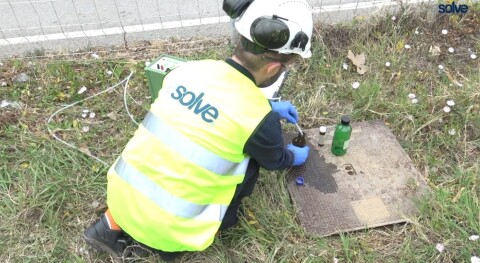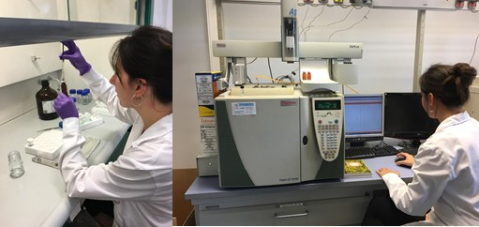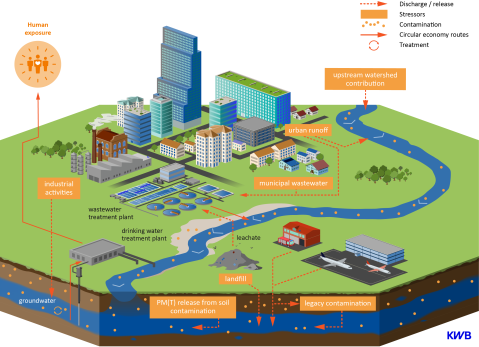CS #7: Remediation of groundwater affected by PFAS and organochlorines, Northeastern Spain
Our aim: restoring polluted groundwater
Case Study 7 considers two aquifers in northeastern Spain: one contaminated with polyfluoroalkyl substances (PFAS) and the other contaminated with chlorinated solvents. Different oxidation/reduction processes (e.g. persulfate, ferrate, nano-zero valent iron) were tested at the laboratory scale to find the best solution for degrading these pollutants.
The most effective best reagent combination for removing PFAS was scaled up to the field scale to remediate the polluted groundwater in-situ. Additionally, a simple box model capable of predicting the fate and transport of PFAS in groundwater was developed.
Find here the full description of both sites.
Conclusion
In order to build the PFAS fate and transport model, saturated column experiments were conducted to study the behavior of pollutants in groundwater and in contact with soil (PFAS adsorption). We incorporated all available parameters to model PFAS adsorption in the unsaturated and saturated zones. PFAS transport models are described in this report.
VOC-polluted site (Site 1)
The treatment strategy was based on the effectiveness of eight novel oxidation treatments, including persulfate (PS), ferrous sulfate, sulfidated nano-zero valent iron (S-nZVI), and potassium ferrate, along with their combinations. The results obtained at lab-scale indicated that the PS and S-nZVI combination with 10 mM oxidizing agent and 5-hour of reaction time effectively removed contaminants in synthetic groundwater (89% DCE, 87% TCE, 59% PCE). In real groundwater, performance decreased, with 94% TCE and 73% PCE removal over 5 hours. A 24-hour spiked experiment achieved 69% DCE, 99% TCE, and 92% PCE removal without harmful by-products. The findings suggest longer reaction times may be needed for complete chlorinated solvent removal in real groundwater, and further field-scale studies are necessary for real-world applications.
Further field-scale studies are required to assess its practical effectiveness for in situ pollutant remediation. This study was published in Water Journal (Cano-Lopez et al., 2024).
Regarding PFAS compounds, we have determined that the best reagent combination for PFAS removal is Persulfate + Ferrate (VI), achieving removal rates between 67 and 95 percent in column experiments using spiked groundwater and soil from the case study. Additionally, a tracer test has been conducted in the field. In early July, we will scale up the treatment to implement it at field scale (only for the aquifer contaminated with PFAS).
PFAS-polluted site (Site 2)
In order to adjust the in-situ chemical oxidation, a first period of lab testing was performed in order to select the best oxidant combination and dosages to degrade PFAS. The designed workflow consisted of first tests with synthetic groundwater that mimicked the groundwater from Site 2, then with real groundwater and finally with real groundwater and soil from the site, in batch and column. Lab-scale experiments demonstrated that the best option for PFAS removal from groundwater using an ISCO strategy was the use of PS activated with Fe(VI), in front of the activation of persulfate with nZVI. The combination and dosage chosen for the ISCO field testing were two sets of injections separated in 20 days of a solution 10 mM PS activated with 1 mM Fe (VI) and 30 mM PS with 3 mM Fe (VI), for the first and second sets of injections, respectively.
In the ISCO field testing, the subsurface conditions at the site were not optimal for oxidation processes via point injections, since the characterization of the hydraulic parameters of the site indicated very low permeability and limited dispersion of potential contaminants or solutes. Medium efficiencies of PFAS removal were observed 2 weeks after the injections, at the injection well, 82% for long-chain PFAS (C>6) and 72% for short-chain PFAS (C≤6). In contrast, low efficiencies were observed in the monitoring wells, since the potential desorption of PFAS from the soil matrix might be high in these two wells, with a high increase of 6:2-FTS and PFOS in groundwater after the injections. However, the overall toxicity reduction observed in all three wells ranged from 18 to 89%, suggesting that even the full mineralization of PFAS cannot be assured, at least no degradation by-products (i.e., ultra short PFAS) were being formed during the oxidation process with toxic effects superior to those of the parent compounds. For further tests, the assessment of the full mineralization should be considered by the monitoring of fluorides during the testing.
The pilot test also demonstrated that the injected oxidant potentially promoted the desorption of contaminants retained in the subsurface. The main desorbed PFAS were PFOS and 6:2-FTS.
The on-site treatment strategy based on ultrasonic cavitation have shown excellent results. High-frequency (500 kHz) operation resulted in the complete removal of PFOS within just 180 min of treatment. Under identical operating conditions, PFAS present in groundwater samples, witnessed up to 99% removal within 240 min of treatment. Given the consistent effectiveness of cavitation-based treatment in treating PFAS, our goal is to evaluate the upscaling of ultrasound treatment, which could continuously treat PFAS contaminated water in a cost-effective way. Thus, careful optimization of bench-scale experiments will be undertaken while considering factors such as ultrasound reactor geometry, transducer types and the physicochemical properties of the matrix. The design challenge, which remains the greatest difficulty in upscaling ultrasound-based treatments, will be addressed by implementing advanced computer interface to optimize ultrasound parameters. Future research and development with proper optimization could pave the way for ultrasound to be implemented in real-world scenarios.



